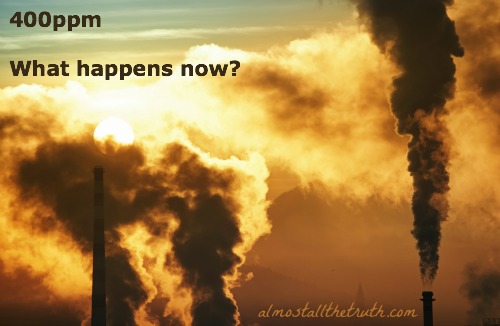We just reached what is likely the most important milestone in our climate‘s history, at least as observed through the lens of humankind. What does that convoluted sentence mean? We’ve reached 400ppm concentrations of carbon dioxide. The highest in millions of years.
I’ll let that sink in a moment.
400ppm. This is the number experts have long thought was the point of no return. This is the number that still may be, although some are considering 450ppm to be the new “worst case scenario.” I am not sure raising the bar in this instance is a good thing when we have a lot more data supporting a number which sparked a fantastic organization that stands for environmental activism: 350.org.
So I am thinking we have a few choices here.
Give up. Throw our hands into the air, declare the war won, and wait for the inevitable.
Hole up and listen to Free Bird on repeat.
Recognize that while the earth may remain, our actions will make sure that our species, along with so many more, will not – stand up and do something!
And I think that includes listening to some of the amazing voices of our time. I was inspired by listening to the Dalai Lama and David Suzuki when they joined our governor and the executive director of Oregon Environmental Council at Portland’s Environmental Summit to discuss what our future can and should look like as our actions change the world for the worse and the better. There are great people who believe we have not passed the point of no return.
Individual actions matter.
Family actions matter.
Large group actions matter.
Policies matter.
We matter.
So what is one small step we can take today to alleviate some of the pressure on our environment? I would love for us all to name one.


Since I’m CelloMom, I feel compelled to answer: drive less!
(In truth, I still drive a car. But I’m also part of a three-house school rideshare, and a five-house rideshare for the dairy run. And I use my bike when I can: I try to schedule all my car-borne errands on at most two days a week. Our house has a weekly car-free day).
Next step: if you must buy a car, right-size it: buy one with as many seats as there are family members. And buy it with the smallest engine available: even that will still be too large.
That is one that everyone could stand to try – I like the idea of a car-free day. When we were in LA a few months ago, I was amazed at how many people could not use the carpool lane. It only required 2 people per car! When I can, I would love to get something smaller. Until then, I can simply drive less. Saves money and emissions. :)
There are so many small changes that each of us can make! I would have to place eating less meat at the top of my list. It’s been estimated that the meat industry generates nearly one-fifth of the man-made greenhouse gas emissions that accelerate climate change.
That is a really good one! Especially for those who eat a significant amount of meat without knowing its source.
Most of us know that trees help us deal with some of the CO2 we create … they breathe it in and return clean oxygen back to us. What many may not know is that the CO2 is stored in the tree and every time we cut one down, all of its stored CO2 is released into the atmosphere. So my suggestion is to reduce our use of anything made from wood or wood products.
Ah, a good ol’ tree hugger. :) The rates of deforestation are staggering, although I think they go well beyond using the trees for wood and wood products unfortunately. I am curious what you think about sustainable tree farms?
I guess if I am honest I think we have gone too far. I think the time we could have turned it around was the 1970s before the majority of people were even aware there was a problem. But we can still play things out as long as possible and I think we have to accept wind farms on our doorsteps even if they are noisy.
Alternatively, your suggestion of holing up with Freebird on replay is pretty good :)
Well said, Brenna. As far as I am concerned, the time is still now and we are rife with opportunity. The most substantial change we need to make is one of cultural perspective. Despite the frontage that the environment has garnered over the past decade, the concept of sustainability hasn’t reached enough of us yet. The problem is that sustainability is too often marketed as a technological fix to supplement a wasteful lifestyle. It creates the idea that enough gadgets and gizmos can allow our lifestyle to remain the same while trimming the excess through technology.
The truth is that sustainability is the lifestyle. It’s a mentality that revolves around the idea of balance and stasis. Recognizing this underscores that our ability to make progress hinges on our readiness to change the way we live. The more people that can accept that and be open to a solution that involves material change, the closer we’ll be to gaining some ground.
Pingback: Climate Change After Mid-Term Election - Almost All The Truth